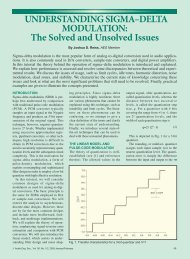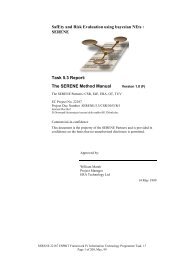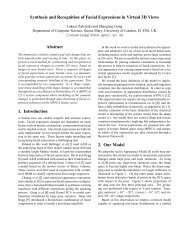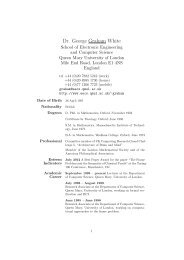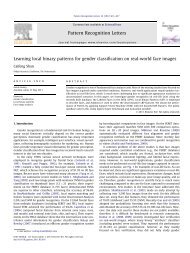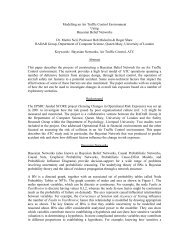DEAP: A Database for Emotion Analysis using Physiological Signals
DEAP: A Database for Emotion Analysis using Physiological Signals
DEAP: A Database for Emotion Analysis using Physiological Signals
Create successful ePaper yourself
Turn your PDF publications into a flip-book with our unique Google optimized e-Paper software.
IEEE TRANS. AFFECTIVE COMPUTING 3<br />
<strong>for</strong> determining an affect curve, shown to be useful <strong>for</strong><br />
extracting video highlights in a movie or sports video.<br />
Wang and Cheong [30] used audio and video features<br />
to classify basic emotions elicited by movie scenes. Audio<br />
was classified into music, speech and environment<br />
signals and these were treated separately to shape an<br />
aural affective feature vector. The aural affective vector<br />
of each scene was fused with video-based features such<br />
as key lighting and visual excitement to <strong>for</strong>m a scene<br />
feature vector. Finally, <strong>using</strong> the scene feature vectors,<br />
movie scenes were classified and labeled with emotions.<br />
Soleymani et. al proposed a scene affective characterization<br />
<strong>using</strong> a Bayesian framework [31]. Arousal and<br />
valence of each shot were first determined <strong>using</strong> linear<br />
regression. Then, arousal and valence values in addition<br />
to content features of each scene were used to classify<br />
every scene into three classes, namely calm, excited positive<br />
and excited negative. The Bayesian framework was<br />
able to incorporate the movie genre and the predicted<br />
emotion from the last scene or temporal in<strong>for</strong>mation to<br />
improve the classification accuracy.<br />
There are also various studies on music affective characterization<br />
from acoustic features [32]–[34]. Rhythm,<br />
tempo, Mel-frequency cepstral coefficients (MFCC),<br />
pitch, zero crossing rate are amongst common features<br />
which have been used to characterize affect in music.<br />
A pilot study <strong>for</strong> the current work was presented in<br />
[35]. In that study, 6 participants’ EEG and physiological<br />
signals were recorded as each watched 20 music videos.<br />
The participants rated arousal and valence levels and<br />
the EEG and physiological signals <strong>for</strong> each video were<br />
classified into low/high arousal/valence classes.<br />
In the current work, music video clips are used as the<br />
visual stimuli to elicit different emotions. To this end,<br />
a relatively large set of music video clips was gathered<br />
<strong>using</strong> a novel stimuli selection method. A subjective test<br />
was then per<strong>for</strong>med to select the most appropriate test<br />
material. For each video, a one-minute highlight was<br />
selected automatically. 32 participants took part in the<br />
experiment and their EEG and peripheral physiological<br />
signals were recorded as they watched the 40 selected<br />
music videos. Participants rated each video in terms of<br />
arousal, valence,like/dislike, dominance and familiarity.<br />
For 22 participants, frontal face video was also recorded.<br />
This paper aims at introducing this publicly available 2<br />
database. The database contains all recorded signal data,<br />
frontal face video <strong>for</strong> a subset of the participants and<br />
subjective ratings from the participants. Also included<br />
is the subjective ratings from the initial online subjective<br />
annotation and the list of 120 videos used. Due to<br />
licensing issues, we are not able to include the actual<br />
videos, but YouTube links are included. Table 1 gives an<br />
overview of the database contents.<br />
To the best of our knowledge, this database has the<br />
highest number of participants in publicly available<br />
databases <strong>for</strong> analysis of spontaneous emotions from<br />
2. http://www.eecs.qmul.ac.uk/mmv/datasets/deap/<br />
Number of videos 120<br />
TABLE 1<br />
<strong>Database</strong> content summary<br />
Online subjective annotation<br />
Video duration 1 minute affective highlight (section 2.2)<br />
Selection method<br />
No. of ratings per video 14 - 16<br />
Rating scales<br />
60 via last.fm affective tags,<br />
60 manually selected<br />
Arousal<br />
Valence<br />
Dominance<br />
Rating values Discrete scale of 1 - 9<br />
Number of participants 32<br />
Number of videos 40<br />
<strong>Physiological</strong> Experiment<br />
Selection method Subset of online annotated videos with<br />
clearest responses (see section 2.3)<br />
Rating scales<br />
Rating values<br />
Recorded signals<br />
Arousal<br />
Valence<br />
Dominance<br />
Liking (how much do you like the video?)<br />
Familiarity (how well do you know the video?)<br />
Familiarity: discrete scale of 1 - 5<br />
Others: continuous scale of 1 - 9<br />
32-channel 512Hz EEG<br />
Peripheral physiological signals<br />
Face video (<strong>for</strong> 22 participants)<br />
physiological signals. In addition, it is the only database<br />
that uses music videos as emotional stimuli.<br />
We present an extensive statistical analysis of the<br />
participant’s ratings and of the correlates between the<br />
EEG signals and the ratings. Preliminary single trial<br />
classification results of EEG, peripheral physiological<br />
signals and MCA are presented and compared. Finally,<br />
a fusion algorithm is utilized to combine the results of<br />
each modality and arrive at a more robust decision.<br />
The layout of the paper is as follows. In Section 2<br />
the stimuli selection procedure is described in detail.<br />
The experiment setup is covered in Section 3. Section<br />
4 provides a statistical analysis of the ratings given by<br />
participants during the experiment and a validation of<br />
our stimuli selection method. In Section 5, correlates between<br />
the EEG frequencies and the participants’ ratings<br />
are presented. The method and results of single-trial<br />
classification are given in Section 6. The conclusion of<br />
this work follows in Section 7.<br />
2 STIMULI SELECTION<br />
The stimuli used in the experiment were selected in<br />
several steps. First, we selected 120 initial stimuli, half<br />
of which were chosen semi-automatically and the rest<br />
manually. Then, a one-minute highlight part was determined<br />
<strong>for</strong> each stimulus. Finally, through a web-based<br />
subjective assessment experiment, 40 final stimuli were<br />
selected. Each of these steps is explained below.




